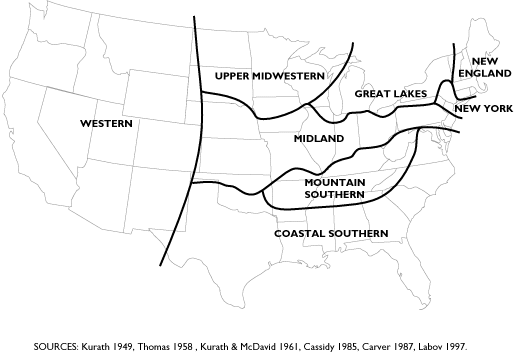
Evolution
PO Box 1333
Merchantville NJ 08109, USA
Email: info@arxpub.com
 Evolution |
Evolution
Publishing PO Box 1333 Merchantville NJ 08109, USA Email: info@arxpub.com |
|
|
|
||

| Traditionally, dialectologists
have listed three dialect groups in the
United States: Northern, Midland, and Southern--although some scholars
prefer a two-way classification of simply Northern and Southern, and
one may also find significant difference on the boundaries of each
area. The map shown above represents a synthesis of various independent
field studies this century. These are in chronological order: the
Linguistic Atlas fieldwork begun under the direction of Hans Kurath in
the 1930's; the informal but extensive personal observations of Charles
Thomas in the 1940's; the DARE fieldwork of the 1960's under Frederic
Cassidy; and the Phonological Atlas fieldwork of William Labov during
the 1990's. Although it may seem that a great amount of data has been collected over a short time span, the shifts in American dialects this century have been rapid enough to outpace the data collection. What appears to be a well-entrenched dialect marker today such as the Northern Cities Shift, may barely appear in earlier studies--affecting both classification and mapping. Nevertheless, some basic observations on current American linguistic geography can be made. The New England Dialects These dialects are non-rhotic, dropping r's before consonants and at the end of words. This area is further subdivided into Eastern New England, including Boston and much of Maine, where O and AU shift into an intermediate vowel so that cot and caught are merged. Transitional between Eastern New England and New York, Western New England is less well defined. Providence retains R-dropping, but does not merge O and AU. The New York Dialects New York City has a rather anomalous linguistic situation, in that its local dialect was not reproduced further westward and therefore cannot be fit into any larger regional grouping such as New England or the Midland.(1) Like New England, the dialect is R-dropping--other features are more generally common to the Northeastern seaboard. The Hudson Valley dialect of Albany, though R-preserving, is nevertheless close enough to New York City's to be grouped with it: both of them shared a Dutch linguistic substratum which is now only vestigial. The Great Lakes Dialects Among all the dialect regions, the Great Lakes region is perhaps the most homogenous, since the major cities in this area (Syracuse, Rochester, Buffalo, Cleveland, Detroit, Chicago, Milwaukee) are simultaneously undergoing a chain shift known as the Northern Cities Shift, with a rotation of the short vowels so that "they may be heard as members of another phoneme by listeners from another dialect area with consequent confusion of meanings: Ann as Ian, bit as bet, bet as bat or but , lunch as launch, talk as tuck , locks as lax" (Labov 1991). This area is fully R -preserving, even though the earliest settlers of this area were primarily New Englanders. At present New England influence is evident only in the lexicon. The Upper Midwest Dialects This area is characterized mainly by a conservative vowel scheme, where the long vowels (often attributed to Scandinavian influence) have remained purely monophthongal, exemplified in the widely known long O in the name Minnesota. Along the northern border are found Canadianisms such as the centralized long I in fuyr (fire) and the centralized ow "uh-oo" in : ouwt (out). The Midland Dialects Midland dialects retain R in all positions, and long I is not flattened (monophthongized) as uniformly as in the South, but the Midland is otherwise not very easy to describe as a whole, since "each of the Midland cities -- Philadelphia, Pittsburgh, Columbus, Cincinnati, Indianapolis, St. Louis, Kansas City -- has its own local character." (Labov 1997). More southerly Midland cities have a typically Southern fronted nucleus in ow, e.g. aout (out); more northerly Midland cities tend not to. Labov (1997) on this basis divides the area horizontally into a North Midland and South Midland.(2) Previous researchers have also seen east-west distinctions, separating the Pennsylvania dialect(s) from those of the Lower Midwest. (Kurath 1949, Thomas 1958, Carver 1989). The Western Dialects Western phonology has only recently begun to diverge, primarily with the merger of AU into the short O class: e.g. cot for both caught and cot, and the fronting of the long U class, e.g. "ih-oo" in words such as two. Otherwise it appears that the Western dialects were formed primarily from a Midland base, since both groups are similarly conservative in their phonology--in fact it was certainly Midland and Western dialects which were so often lumped together under the catch-all phrase "General American".(3) Westward migration has also carried typically Northern features into the Pacific Northwest, and Southern features into the Southwest: both phonology (Labov 1997) and lexicon (Carver 1989) have been affected. Endnotes (1) Many scholars have defined New York City as "Northern" by virtue of its geographical location: but naming a "Northern" group of dialects is misleading if it implies the kind of shared phonology which we see in the Southern dialects. I share the view that a general term "Northern" makes the most sense if used the way most Americans would understand it: i.e. any dialect that does not have the full monophthongization of long I and is therefore not Southern. (2) The South Midland described in Kurath 1949 and Kurath and McDavid 1961 is wholly different from Labov's, referring to the area here termed Mountain Southern. Kurath's "North Midland" is called here, as in Labov, simply Midland. (3) See particularly Thomas 1958, which merges the Midland with a large part of the West, while cordoning off the Northwest and Southwest Coast with, as he admits, "ill-defined" boundaries. Modern linguists have been sharply critical of the now disused term "General American" but it does seem that in the early 20th century a huge area of the country used a quite similar phonology. Bibliography Carver, Craig M. 1989. American Regional Dialects: A Word Geography. Ann Arbor:University of Michigan Press. Cassidy, Frederic G., ed. 1985-. The Dictionary of American Regional English. Cambridge:Belknap Press. Kurath, Hans. 1949. A Word Geography of the Eastern United States. Ann Arbor:University of Michigan Press. Kurath, Hans and Raven I. McDavid. 1961. The Pronunciation of English in the Atlantic States. Ann Arbor:University of Michigan Press. Labov, William. 1991. The Three Dialects of English. In Penny Eckert, ed. New Ways of Analyzing Sound Change. New York:Academic Press, pp. 1-44. Labov, William, Sharon Ash and Charles Boberg. 1997. A National Map of the The Regional Dialects of American English. Thomas, Charles K. 1958. The Phonetics of American English. New York. |
|